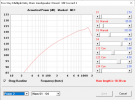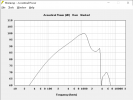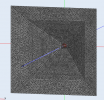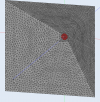OP
AwesomeSauce2015
Active Member
- Joined
- Apr 14, 2022
- Messages
- 204
- Likes
- 195
- Thread Starter
- #41
I sort of figured out Hornresp... Turns out the help file is actually useful if I am stuck lol.
On the upside, if I simulated it correctly, I should be able to hit my SPL target. Hornresp seems to think that if I slam >500w into 4 B&C 4NDF34-8, then I'll get around 120db as I approach 1khz, where I then will cross over to the DE250. Of course, the DE250 will hardly be breaking a sweat at 120db, whereas the midranges will be a molten mess...
The main issue is that since the horn is so small, I get no loading below 900hz. Hence, my need for insane amounts of woofer displacement.
I will probably redo the simulation with larger drivers and entry ports further down the horn.
Edit: I think I finally know the answer to the thread's main question: Yes, I am officially crazy for thinking this is possible! But, with a liberal application of POWAHHH I think it's doable.
On the upside, if I simulated it correctly, I should be able to hit my SPL target. Hornresp seems to think that if I slam >500w into 4 B&C 4NDF34-8, then I'll get around 120db as I approach 1khz, where I then will cross over to the DE250. Of course, the DE250 will hardly be breaking a sweat at 120db, whereas the midranges will be a molten mess...
The main issue is that since the horn is so small, I get no loading below 900hz. Hence, my need for insane amounts of woofer displacement.
I will probably redo the simulation with larger drivers and entry ports further down the horn.
Edit: I think I finally know the answer to the thread's main question: Yes, I am officially crazy for thinking this is possible! But, with a liberal application of POWAHHH I think it's doable.











